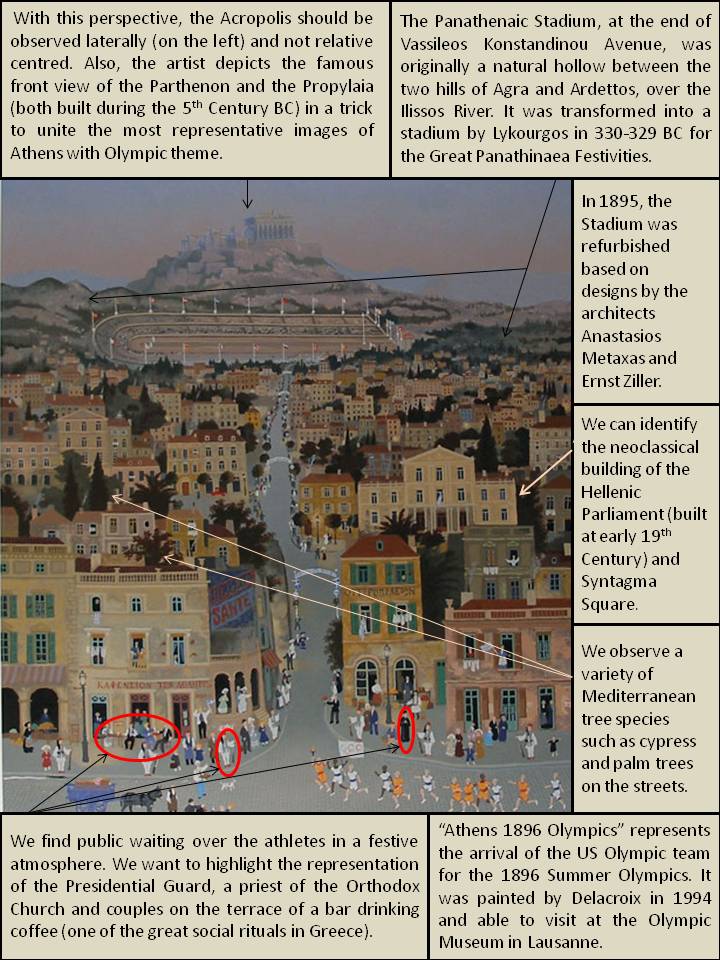ATHENS (Michel Delacroix, 1994)
This work of art represents the arrival of the US Olympic team for the 1896 Summer Olympics celebrated in Athens and it was painted by Michel Delacroix in 1994. The author was commissioned to create a series of paintings that commemorate the 100th Anniversary of the Modern Games by the Atlanta’96 Olympic committee. «Athens 1896 Olympics» can be visited at the Olympic Museum in Lausanne, Switzerland. This picture is an example of landscape painting that characterizes the Naïf style of Delacroix and his particular vision of urban life.
The city of Athens is the capital of Greece, a country placed in Europe’s southeast. It is placed in the south of Attica region and borders in the southern part of the Saronic Gulf. The rest of the city is limited by the Mounts Aegaleo, Parnitha, Penteli and Hymettus; placed respectively in the west, northwest, northeast and east. The foundation of the city dates back to 7000 B.C. and it had its major expansion during the 20th Century. Nowadays, the tourism in its six archipelagos and the archaeological deposits constitutes the economic engine of the country. In the picture we can observe a great variety of arboreal species as cypresses and palm trees, which correspond to the Mediterranean dry climate of the Hellenic country.
The image focuses on the Panathenaic Stadium aid of a large central Avenue (inspired by Vassileos Konstandinou Avenue) that leads the eye to it. It was originally a natural hollow part of the ground between the two hills of Agra and Ardettos, over the Ilissos River, in the current Pangrati neighbourhood. It was transformed into a stadium by Lykourgos in 330-329 BC for the athletic competitions of the Great Panathinaea Festivities. In 1895, the Stadium was refurbished based on designs by the architects Anastasios Metaxas and Ernst Ziller. The focus in the Stadium is reinforced by the uniformity of colours and structures in urban construction. This is one of the licenses that the author is taken in its representation of Athens 1896. It is common in all the work of Delacroix that his cities present an orthogonal planning regardless of the reality of the city or the time. The real planning of Athens is very irregular and chaotic in this old city area. This irregularity is interrupted only by the large quadrangular Syntagma Square where the Parliament is located. In the picture, though an unreal placement, we can identify the neoclassical building of the Hellenic Parliament (built between 1836 and 1843) and Syntagma Square in the right margin.
The Olympic Stadium with its characteristic forked form and crowned by the flags of the participating countries listed in an environment that is not fully correspond to reality. With this perspective of the Stadium, the Acropolis should be observed laterally (on the left) and not relative centred. Also, the artist depicts the famous front view of the Parthenon and the Propylaia (both built during the 5th Century BC) in one more trick to unite the most representative images of Athens with Olympic theme.
Likewise, we find public waiting over the American athletes in a festive atmosphere. We want to highlight the representation of three people at the bottom of the painting that define some of the most important Greek social characteristics: the Presidential Guard and their characteristic uniforms, a priest of the Orthodox Church and couples on the terrace of a bar drinking coffee (one of the great rituals in Greece). This restaurant is surrounded by other commercial buildings. We can also see people participating at the windows from their private homes (appears hanging clothes).
To conclude, we want to emphasize the relevancy of the city of Athens and the Hellenic culture for two factors: for being the cradle of the democracy and the origin of the Olympic Games. The Greek civilization is at the origin of the Europe through that we live at present and the Olympics have turned into the major one and more out-standing sports event worldwide. Our country could enjoy the honour of organizing the Games in the year 1992, in Barcelona.
Irene Alquézar Pacheco

